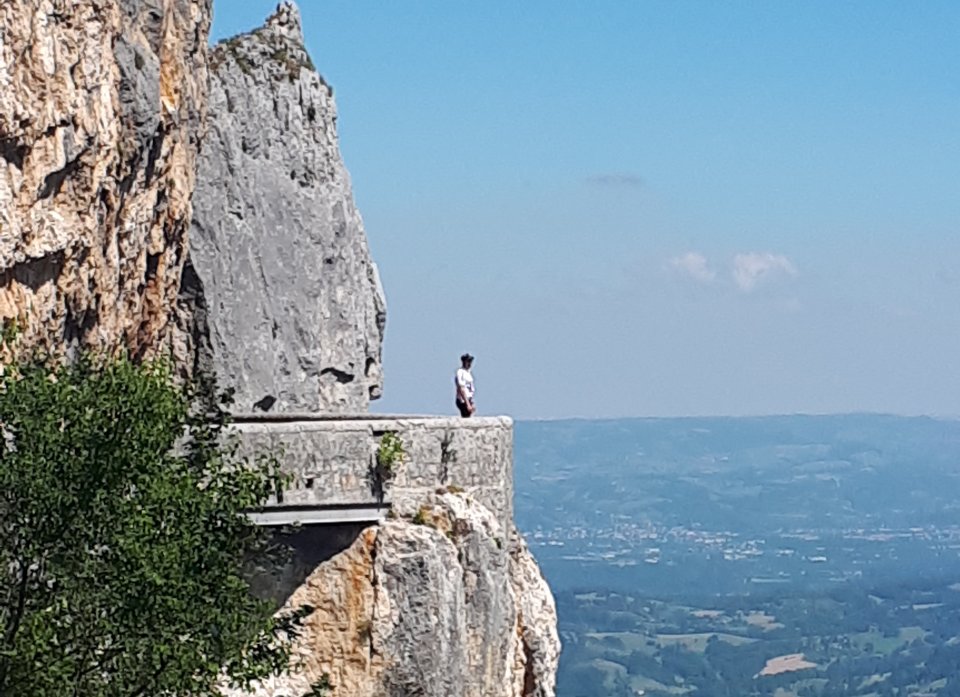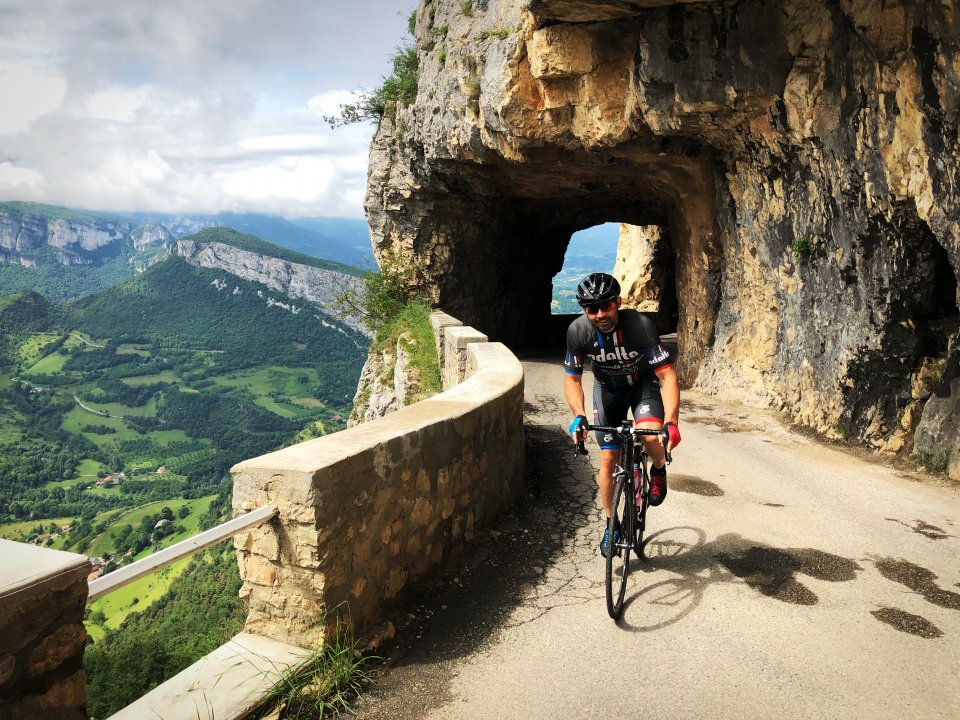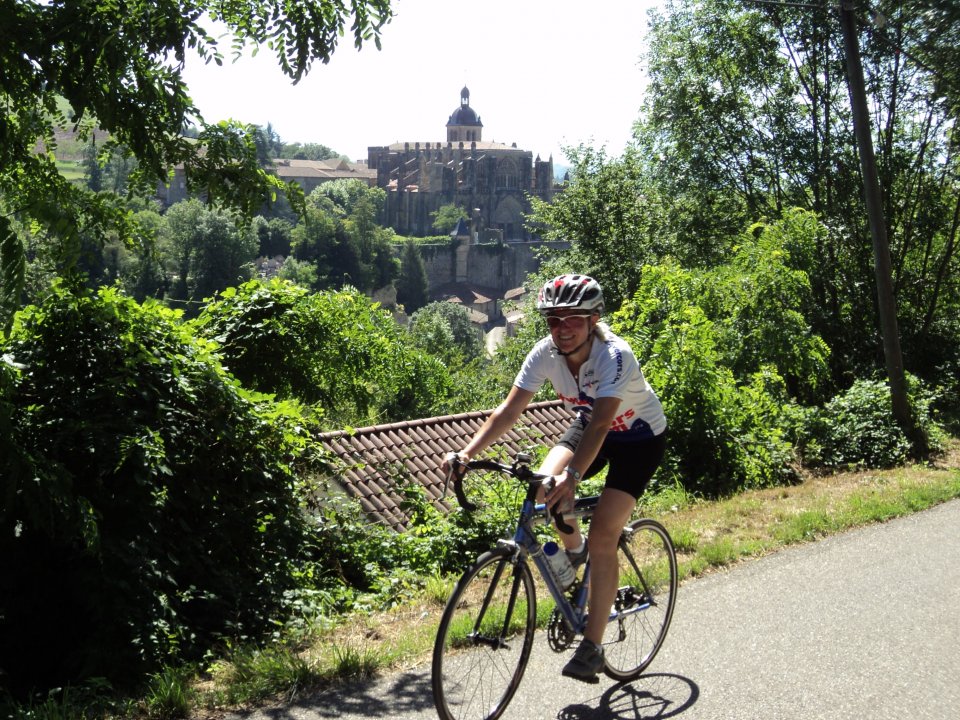Routes
A huge choice of routes directly from our base
A huge choice of routes directly from our base
Quiet, mainly pot-hole free, black top roads make the Vercors a superb region for road cycling. We have a vast library of routes built up over the past 35 years riding in the Vercors. All of our routes start and finish at our base in the town of St.Jean-en-Royans. We are nestled at 240m, within a short ride to the 3 main gateways up to the Vercors Plateau. All routes are available as GPS files and our 'Velo Vercors' route guide provides a description of each route, statistics and even has star rated cafe stops.

There are five distinct areas in the Vercors National Park and the Vercors Dromoise or the Medium Vercors is the main plateau above St. Jean and where most of the Velo Vercors riding takes place. There are three main gorges leading up to the plateau. To the north, the Gorges de la Bourne going all the way to Villard-de-Lans. In the middle, the Goulets rising up to a tunnel to access the plateau below La Chapelle. And, to the south, the famous Combe Laval, which has no exit due to its shear back wall, but there is access either side via two roads. The Medium Vercors is an area of superb riding, with breathtaking gorges, precipitous cliffs and rolling alpine meadows. Ranging from 6-20 kms the cols are friendly, with gradients ranging between 5-7% with the odd 10% thrown in for good measure.

It is also the most accessible to Velo Vercors and in high summer offers the cooler temperatures. The classic rides tend to climb the Gorges de la Bourne or Goulets, do a variety of circuits on the plateau and then descend the Combe Laval to return to St. Jean. Both the Goulets and Bourne also make great descents, but the Combe Laval is special. One of most spectacular balcony roads in France, a national heritage site and a complete adrenaline rush for cyclists'. A super climb but much more fun to descend, traversing the high edge of the gorge, with the limestone fortress on your left and a 400m sheer drop into the heart of the gorge, on your right, with only a low wall barrier as protection to make it feel very real. From the viewing area just after the Col de la Machine hotel the roller coaster fun begins as you enter one of the many hand cut tunnels to emerge onto the narrow ledge road with spectacular views across the gorge as you twist and turn through more tunnels and stone arches to emerge at the 45th parallel where the road opens out to 2 lanes and you look back to the limestone citadel you have just travelled. From this point the route launches itself through another series of twists and turns deep into the forest to emerge at Velo Vercors. Still high as a kite you may be one of our guests who can't hold themselves back from saying 'That's the best day's cycling I've ever had' !

The Royans or the Low Vercors around St. Jean stretching from the Isère river to the steep walls of the Vercors to the east offers a fabulous network of flattish and undulating riding opportunities on small lanes and quiet main roads perfect for leisurely rides. While meandering through hamlets, you'll be delighted by the stunning scenery around and above you. Quiet roads flanked by walnut groves, swathes of sunflowers, barley, wheat, maize, cherry and apricot trees with views up to the limestone fortress that is the Vercors massif. All our routes leave directly from our front door and range from 10 km - 142 km. You set your own pace, a pace that allows you to breathe in the fresh air, to stop to take in the stunning views, to take time to appreciate the flora and the fauna unique to this region. There's no rush - you're on holiday and you have all day. All our routes highlight cafe stops for coffee, cake or a local dish. Put in the miles and savour the moment on roads less travelled, away from the crowds.

9 km from us is the picturesque town of Pont-en-Royans famous for its suspended houses built into the rock overlooking the Bourne river with a number of cafe and restaurants perched along the river bank making it a perfect cafe and restaurant stop. It is also the gateway to the stunning Gorges de la Bourne and the first 12 km up the gorge remains fairly flat offering you the opportunity to ride into a gorge and to hear and see the magnificent bourne river gushing through the gorge below. At the small hamlet of Choranche the road starts to become a bit steeper so you may want to whizz down and continue on your route back to St. Jean or you may be so enchanted you'll want to push further into the mouth of the gorge to cycle along its jaw dropping high edge road, and through the limestone carved tunnels for some spectacular photo opportunities.

Another popular route for those who want a more leisurely ride or a long, flat day ride is to the dedicated cycling path via another medieval town, St.Nazaire inhabited since pre-historic times and renowned for its vast 19th century aqueduct built. There are 2 routes to get to St. Nazaire, one flatter on the quiet main road or the 'back route' with a small friendly climb, rolling terrain and fabulous views across the Isere valley. Either route will bring you to the medieval town perched above the Isere river. Cycling out of town with the river on your right a short 1 km ride will bring you to the start of the tarmaced 'Velo Vert' cycle path which follows the Isere river, crossing over and back at various points through country lanes arriving at Romans-sur-Isere which is worth a visit to see its cobbled streets, XI Cathedral, shoe museum, cafes and restaurants.

To the west of St.Jean is the rolling hills of the Drome, with stunning views over to the Vercors and quiet, agricultural roads leaving you totally unprepared for the awe-inspiring magnificence of St. Antoine de l'abbaye, suddenly appearing through the trees as you descend to its base before climbing up through the narrow, winding, ancient streets. A stop on the Santiago de Compostela pilgrim route (Way of St James) and one of France's Most Beautiful Villages, Saint-Antoine-l'Abbaye is a show case for medieval and gothic architecture with its half-timbered old houses, medieval market hall and abbey founded in 1297 by the Order of St Anthony to house the relics of St Anthony of Egypt. Its rich decor and history is also a favourite location for artisan crafts including jewellers, potters and sculptors. A very special destination and definitely worth a lunch or drink stop in one of the restaurants perfectly positioned on the long gravelled pedestrianised entrance to the Cathedral.

Diois or the Southern Vercors, also known as Drome Provencal is the area to the south of St. Jean, beyond Léoncel to Beaufort and Die. There is a marked change in climate – warmer and drier, with vegetation more like Provence and the start of the lavender fields. A classic circuit for a long distance ride is the 130 km ride to Die. A fantastic circuit with long, winding ascents, twisty technical descents and a climb up on the the prettiest valleys in the whole region. On top of that, it has the famous Col de Rousset climb from Die with its sinuous path up to the ski station at 1,254 m. Used three times in the Tour de France, the climb has amazing views across the southern Vercors and a dramatic lookout point at the top, where a tunnel cuts through the imposing cliffs. Passing through breathtaking scenery to the historical town of Vassieux-en-Vercors with its museum and memorial to the resistance to the last climb before a sensational descent through winding alpine meadows and forests before descending the Combe Laval and its epic balcony road. This is a 'must do' route.

Coulmes or the Northern Vercors is an area to the north of the Gorges de la Bourne with heavily wooded rounded slopes and a steep western flank down to the Isère valley. The narrow gorges leading up to Coulmes are some of the steepest and most sustained climbs in the region. Hauts Plataeux and Quatre Montagnes or the High Vercors – the area to the far east and north of the Vercors is the highest rising to 2,341m (Le Grand Veymont). This area has excellent skiing, mountaineering and mountain biking, but very few roads suitable for riding.

All our routes are available as GPX files. Our Velo Vercors guide book written and compiled by Dominic Lowden is a fantastic tool for guests, with detailed descriptions of each ride highlighting distance, climbing and indicating if the terrain is flat, punchy, hilly or ultra-hilly. There's even a star rating of cafes en route for those all important coffee or lunch stop.

The balcony road most widely known in the Vercors is the Combe Laval, which I've mentioned in the main section, but there are other spectacular balcony roads cut through the many gorges, right on our doorstep. Gorge du Nan is right up there. A narrow gorge cutting through the rock face leading to a narrow section as the road turns and below is a sheer drop into the gorge with stunning views down to Cognin and the surrounding areas below, before it widens into a wooded basin that continues to climb to 1200m. One of our favourites is the Gorge de la Bourne that gets more narrow and more exhilarating after the first 12kms. The road narrows as you head into the mouth of the gorge with the rock face so close you can reach out and touch it, while on your right is a sheer drop into the wooded gorge and the Bourne river far below. Continuing in the direction of Villard-de-Lans you will cross the Bourne via the famous Goule Noire Bridge (intersection with the St-Julien-en-Vercors road), a titanic work that overhangs the cave of the same name, from which water from the Autrans-Méaudre valley gushes out. The balconies continue after the Valchevrière Bridge and the road narrows to its minimum before widening out again at Jarrands (intersection with the Méaudre road) then peacefully continuing to Villard-de-Lans.
Stunning views at every turn ...
Its not always possible to go around the rock face so the only way is through! Most of these tunnels are well lit but it is still a good idea to have lights on your bike.
There is water everywhere in the Vercors, constantly trickling through the porous limestone rocks keeping the landscape green and lush throughout the season and manifesting as gushing rivers, waterfalls and canals downstream giving you lots of fantastic photo opportunities and a spot of wild swimming if that takes your fancy. Many of our routes follow and cross the 2 main rivers; The Isere, originating from the Sources de l'Isere in the Vanoise National Park in the Savoie, near to the ski resort of Val d'Isere and the shorter Bourne river beginning at Lans-en-Vercors and flowing downstream through the Gorges de la Bourne into the Isere at St.Nazaire covering a 42 km course and1,070m vertical drop with numerous tributaries along the way. Lots of stunning waterfalls to admire and to bathe in, not forgetting the splash pool filled with fresh mountain water or the 'ice cold' canal to plunge in on a hot summers day back at Velo Vercors.